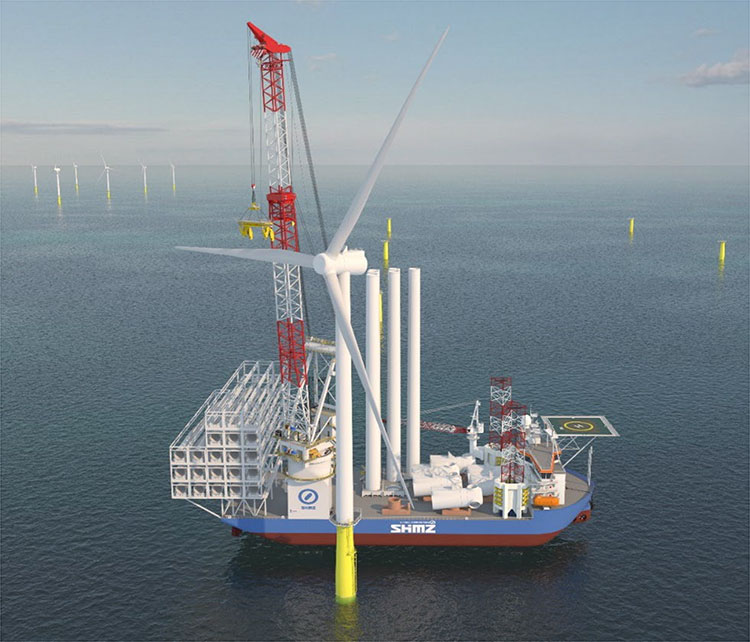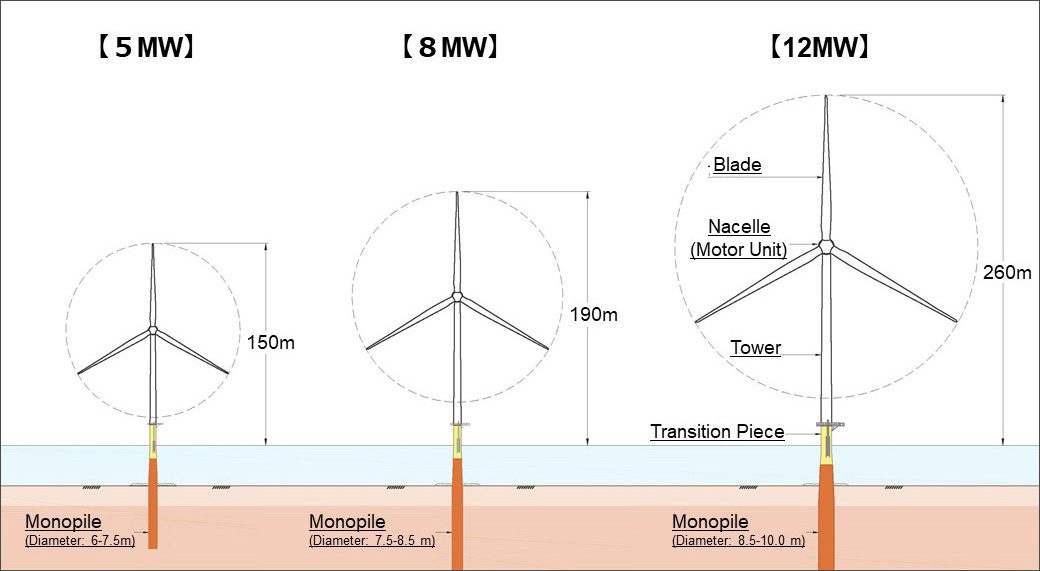July 24, 2019
Next month Shimizu Corporation (President: Kazuyuki Inoue) will begin construction of a highly efficient self-propelled SEP vessel (SEP: Self-Elevating Platform) equipped with the world’s largest transporting and crane capacity and capable of installing ultra-large-scale offshore wind turbines. Shimizu is investing roughly 50 billion yen in the project and plans to bring in orders for the construction of offshore windfarms, a market estimated to be over 5 trillion yen. Completion is scheduled for October 2022. Shimizu will increase its competitiveness in the renewable energy sector and further expand its engineering business through this project.
Japan`s new `Act to Promote Offshore Use by Offshore Renewable Energy Facilities` was enacted in April of this year and the offshore wind power market is projected to rapidly expand. Planning is currently underway in Japan for a publicly-disclosed total of 10 million kW of offshore windfarm power generation capacity. Electric power providers are focusing on economic efficiency and are planning to use large wind turbines of the 8 and 12 MW class, which have not yet been used in Japan.
Windfarms using large 6 to 8 MW offshore wind turbines have already been constructed for commercial power generation in Europe. Electric power companies and wind turbine manufacturers in Europe and the US are now planning highly profitable ultra-large-scale wind turbines of 9 to 12 MW. Wind turbines of 8 MW and larger will become essential in Japan, just as they have in Europe, as the unit costs of power generation decrease and offshore construction in limited areas impacts scale and profitability.
There are currently no SEP vessels in Japan capable of installing wind turbines of the 8 MW class or larger and because of high demand in Europe, it is not easy to charter a large SEP ship. Shimizu therefore decided to build a SEP vessel equipped with the world’s largest transporting and crane capacity and will obtain EPC orders for the construction of offshore windfarms that are being planned in Japan.
The SEP vessel to be constructed will have an overall width of 50 m, a length of 142 m, and a gross tonnage of 28,000 t. It will be equipped with a crane with a maximum lifting capacity of 2,500 t and a maximum lifting height of 158 m, which will make it world class in terms of operating performance. The ship will be operational in depths ranging from 10 to 65 meters, and it will have four legs implanted in the ocean floor during operation. It will be insulated from the ocean surface by jacking up the hull, ensuring wave-resistant stable operations.
The first step for installing a wind turbine using a SEP vessel is to drive the monopiles into the ocean floor. The SEP vessel then loads and transports the wind turbine tower, nacelle (motor unit) and blades, and mounts them onto the monopiles. The SEP vessel Shimizu is building will be able to carry all of the parts for seven 8 MW wind turbines, or three 12 MW wind turbines, and will be able to install seven 8 MW wind turbines in 10 days or three 12 MW wind turbines in five days, including preparation. The design will also enable the vessel to be jacked up and down during the 10-second long swells that are characteristic of the Pacific Ocean, to achieve operational efficiency 50% higher than existing SEP vessels.
Shimizu collaborated with GustoMSC B.V., a European engineering company, for the planning specifications and design of the ship beginning in October 2018. Japan Marine United Corporation will manufacture the ship and Shimizu will collaborate with Fukada Salvage & Marine Works Co., Ltd., which owns numerous working ships, for operation management.
This SEP vessel is the core of the planned investment in infrastructure, renewable energy, and new business outlined in Shimizu`s Mid-Term Management Plan <2019-2023>. Shimizu intends to market the superior operating performance of this SEP ship to electric power companies in Japan and overseas to obtain EPC orders for construction of offshore windfarms.
≪For Reference≫
Image of Self-Propelled SEP vessel to be constructed (attaching blades)

EPC Orders
Construction contracting agreement for the project, including engineering (E), procurement (P) and construction (C).
Partner firms in Japan and Europe
■Japan Marine United Corporation, unlisted
| Location | 4-4-2 Minatomirai, Nishi-ku, Yokohama-shi, Kanagawa 220-0012, Japan | |
|---|---|---|
| President | Kotaro Chiba | |
| Established | January 2013 | |
| Capital | 25 billion yen | |
| Business description | Design, manufacture, purchase and sale of ships, naval and patrol vessels, marine floaters, etc. | |
| Project responsibilities | Detailed engineering and construction of SEP ship | |
■GustoMSC B.V., unlisted
| Location | Netherlands | |
|---|---|---|
| President | Nils Van Nood | |
| Established | 2011 (Founded in 1862) | |
| Capital | €18,000 (December 2017) | |
| Business description | Ship engineering and consulting | |
| Project responsibilities | Conceptual design and basic engineering of SEP ship, engineering and manufacturing of jack system, engineering and manufacturing of crane | |
■Fukada Salvage & Marine Works Co., Ltd., unlisted
| Location | Chikko 4-1-1, Minato-ku, Osaka 552-0021, Japan | |
|---|---|---|
| President | Toshio Yamamoto | |
| Established | July 1951 | |
| Capital | 650 million yen | |
| Business description | Offshore engineering projects and ocean development related business, salvage and towing of vessels in distress, etc. | |
| Project responsibilities | Examination of construction specifications, personnel allocation plans, ship operation plans | |
Wind Turbine Scale

The information contained in this news release is the current information on the date of publication. Please be aware that this information may have changed by the time you view it. Please contact the company to inquire for further details.
